#Chinese Mythology: An Introduction
Explore tagged Tumblr posts
Text
"So in the end, God issued a command allowing Yü to spread out the self replacing soil so as to quell the floods in the Nine Provinces."
Quote randomly selected from page 81 of Anne Birrell's nonfiction book Chinese Mythology: An Introduction
Additional notes: This quote is in and of itself part of a block quote whose citation is given as (Shan Hai Ching, Hai nei ching, SPPY 18.8b-9a). Shan Hai Ching is also romanized as Shanhai jing and translates to Classic of Mountains and Seas.
Quote was selected at random from a book chosen at random from my local library.
#Books#History#Mythology#Chinese Mythology#Chinese Mythology: An Introduction#Yu the Great#The Great Flood of Gun-Yu#Anne Birrell#Shanhai jing#Classic of Mountains and Seas
1 note
·
View note
Text



J. C. Leyendecker's "Study for Butterfly Couple" (1923) // unused vinyl design for Arcane's "Pretend Like It's the First Time" episode title card // marble statue of Liang Shanbo & Zhu Yingtai, also known as "Butterfly Lovers" from the eponymous chinese legend
#arcane#timebomb#ekkojinx#WE NEED TO TALK ABOUT TIMEBOMB BUTTERFLIES MORE. I BEG Y'ALL.#something something ekko and jinx are actually the most artistically inspired pairing ever for fortiche something something#actually it's a little bit insane that my first introduction to mythology as a concept was through the book called...#“butterflies in legends and myths” 🤡👍✨ (still very good and honestly very informative book that i have somewhere at home)#also please read that chinese legend. it's so sweet and so heartbreakingly beautiful. also pretty damn queer (crossdressing my beloved).#also. the statue is located in italy. it was as a part of sino-italian love culture festival shared by sister cities - verona and ningbo.#and i hope you know that verona is a place where romeo and juliet's story takes place.#because. well. that festival celebrates both of these tragic love stories actually.
66 notes
·
View notes
Text
So I went and watched two Ne Zha movies. So here’s my quick fire ramblings.
Ne Zha 2019? Amazing! Just absolutely amazing! Balanced comedy and seriousness very well, very compelling characters, really good fight scenes, themes were handled well, made me cry, the dad is hot. The only complaint (and that is but a nitpick) was that I would have loved to see true form/grown up Ne Zha more because that design is stunning.
Reborn? Love the art direction. The setting is awesome. Voice acting is solid af. Mad respect for the more gritty tone/grasps that animation isn’t just for little children and is a medium for expression. But man… I found the fight scenes and antagonist cast underwhelming. Really the motorcycle chase sequences were the best parts action wise. And the evil dad wasn’t even that hot either. And Ao Bing… what have they done to you… I squirmed a lot tho, and teared up at the right times, but still. Could have used more toxic yaoi… huh?
Also my cats went to snuggle up around me when watching Reborn… If you know you know…🥲
#My dumbass thought reborn was a direct sequel to 2019. Boy was I wrong because now I feel empty.#A void that shirtless hot guys can’t fill. Sorry Reborn. I know you tried but I feel numb after all the shit you pulled.#Could Reborn Ao Bing really be called Ao Bing? I just started calling him Blondie Bitch Boy…#Ramblings#ne zha#My boi Ne Zha was literally my introduction to Chinese mythology all the way back in high school btw. By chance no less!#I loved watching the 2019 movie and remembering stuff I spent far too long reading for a simple school project#Everything can be made better with a pinch of toxic yaoi *dunks the entire container*
10 notes
·
View notes
Text
NaNoWriMo: Red Ring of Fate
Hi! I’m Buffy and this is my NaNoWriMo project :) *NOTE FROM FUTURE BUFFY: I did not complete this lol, she is still in progress!

wlw romance, duel POV, chinese mythology elements
“Jingyi is a manager at a cafe, saving up for flight attendant school. Renée is a student at the University of Saskatchewan, months away from getting her bachelor's degree in kinesiology. The two don't recall ever crossing paths, nor seemingly have anything in common. Except they have the same tattoo; a red ring on their pinky finger symbolizing the red string of fate. An ancient Chinese myth about soulmates. The two meet. They suddenly see each other everywhere. They befriend one another. They fall in love. But is love enough when you're both about to head off into the world in different directions? Will the string connecting them snap, when tested by thousands of miles of distance? In this romance story that centres around the Chinese myths that subtly take over two Chinese-Canadians lives, soulmates seem to be more of a choice, than a fate.”

The story has two main characters: Jingyi and Renée
My NaNoWriMo goal is 50,000 though idk how likely that is but I really am just hoping to get this story into motion and break my writer's block that has been bugging me for a few months now!
#rrof#nanowrimo#writeblr#ocs#writer#queer writers#lgbtq#my writing#writers on tumblr#author#writing community#novel writing#creative writing#my wips#current wip#wip intro#story introduction#lesbian#sapphic#wlw#sapphic literature#wlw story#mythology#chinese mythology#folklore
17 notes
·
View notes
Text
Maudit
introduction pt. i | pt. ii | pt. iii
<< previous | m.list | next >>
ch. xxii - peter
cursed!jongho × reader
genre : mythology!au, smau
rating : mature; crude jokes and filthy language
tw : jokes about illegal substances (cannabis), jongho being sentimental, talks about natural death
wc : 2 k
buy me coffee ?
so long i've been here, so long are the stories i've written. of what i gathered and lost, loneliness becomes me and pain refuse to depart from me. i've embraced that which ate me away so when you came along, i had no part of me left to give.
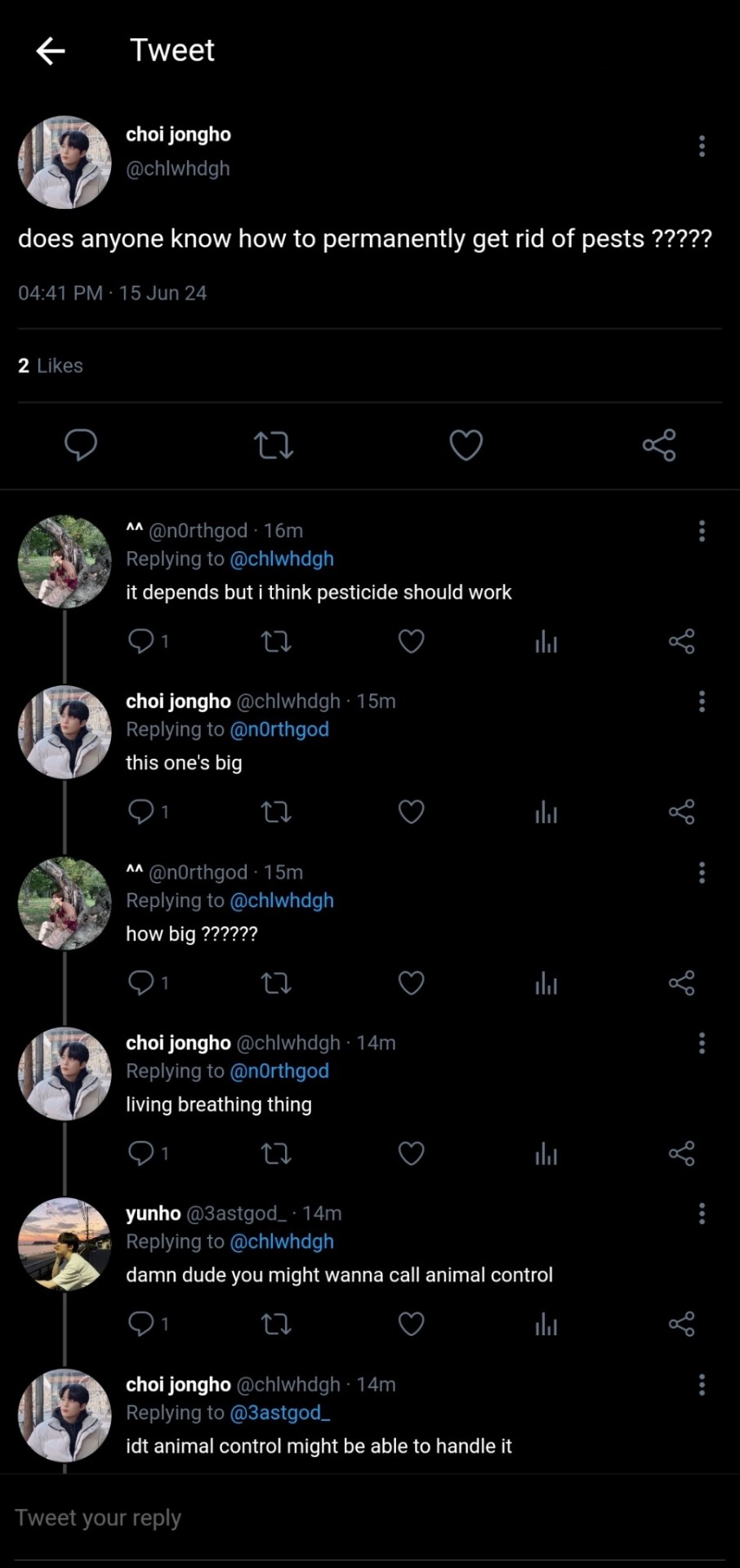
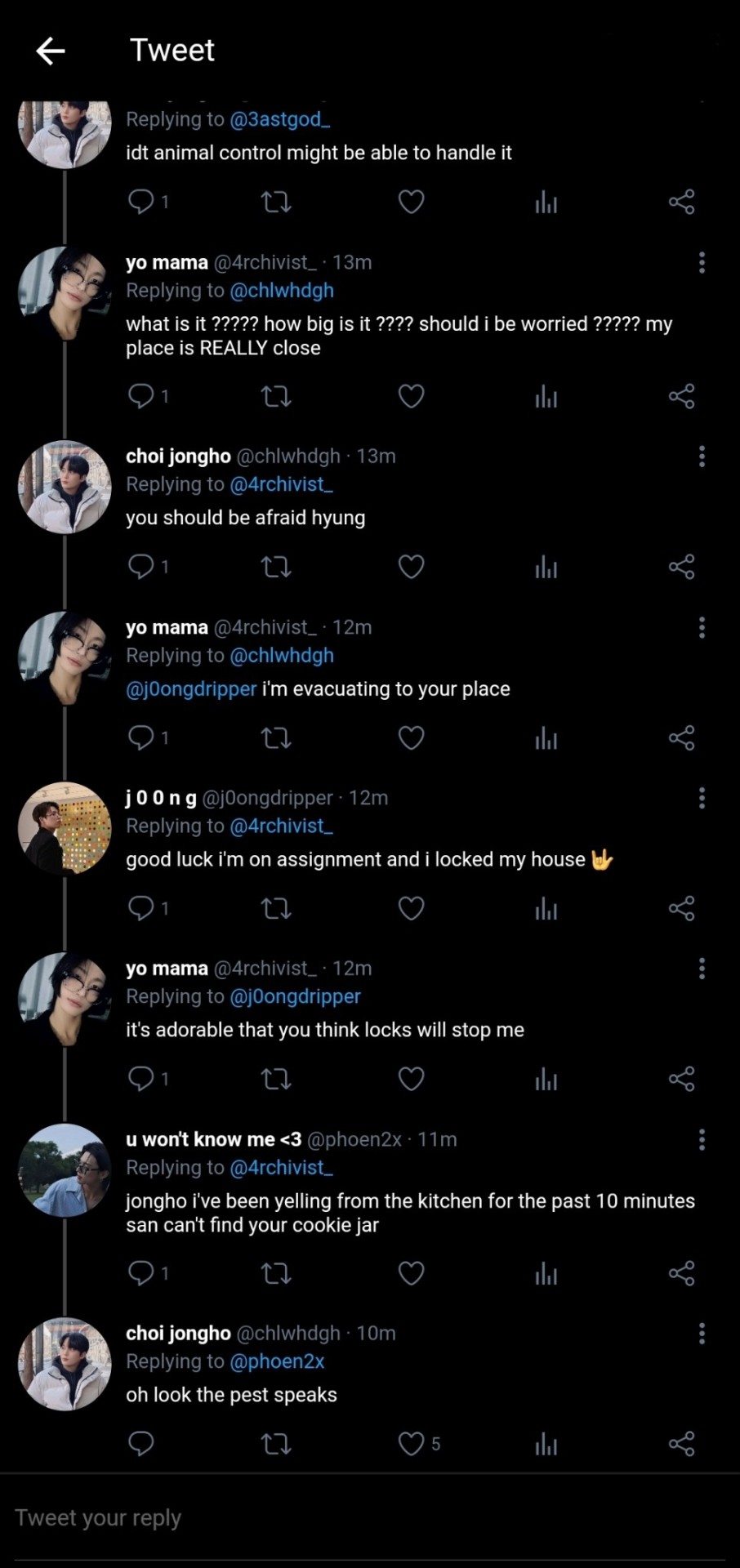

Never in a million years would you have imagined to be in this spot. Seeing your boss, the same guy who not four weeks ago had blatantly told you to keep your personal and professional apart just because you were texting your grand uncle about his stiff joints, in your house with takeout. Well, your grand uncle's house, but still, it was your quarters and he was acting so casual with you. This was not the only casual thing, as he showed up in a big, fluffy hoodie and dark sweatpants, completely taking you off guard. It wasn't like you were expecting him to be wearing suits or business-casual outfits so late, it was just that you had never seen him so comfortable.
"I hope you don't mind Chinese food. I've been craving it, especially noodles for some reason," Jongho said as he slowly pulled containers of food out of the plastic bag. The smell was mouth-watering but it didn't deter you enough to skip over the main issue. "How long have you been craving Chinese food, Jongho? 200 years?" your eyes dart along the five side dish containers on top of the two noodle containers before you.
Sheepishly, Jongho chuckled as he scratched the back of his head, "Well, I didn't know what you like so..." "You got a whole page of the menu?" you finished for him, still looking incredulous. Jongho simply shrugged, "If we don't finish this, we can split the remaining food and keep them as leftovers. Easy." Though he made a point, you still couldn't believe that he had bought so much on his first time stepping into your house. "Even the leftovers would be too much," you grumbled despite looking over the food and thinking about which one to pick first. "If you can't finish this, you can always share with your uncle," Jongho suggested as he dropped himself on the other end of the couch with his noodles, his feet tucked under his thighs as he sat cris-crossed. You settled into a mirroring position, also with your own noodles before you pressed play on your paused movie, Captain America: The First Avenger. "First of all, it's grand uncle, and no I can't share with him because he's old and the doctor is limiting his sodium intake severely so I'm just gonna put this in my fridge," you explained.
Although you lived with your grand uncle, he was nice enough to realize that once you became an adult, you wanted your own space and due to his mobility issue, he decided to give the whole second floor to yourself while he stayed on the first floor. He had assured that you had your own little apartment on the second floor what with your own bedroom, your own kitchen, your own living room and your own bathroom. He had allowed you to transform his entire second floor and all he asked of you was to just not bother him because he needed his rest. So you usually see him maybe four times a week because your schedules tend to make you very occupied outside, but with the help of the caretaker, you were able to be sure that he was doing just fine. When he wasn't cranky.
"I think I saw him earlier while we were going up. It sucks he can't eat this but that just means there's more for you," Jongho said between bites, "Let me tell you, once MSG was introduced, it was just like what happened with cannabis." The way he said the word cocaine so casually made you almost choke your food, but you managed to only cough twice before swallowing and talking, "What the hell do you mean cannabis??" you asked, both scandalized and surprised. "Well," Jongho paused to swallow a mouthful of tangsuyuk he had dipped in sauce, "We used to cook with cannabis leaves because back then we didn't know it was narcotics because there weren't any classifications back then, we just considered it edible weed so we make dishes out of them and where I'm from, cannabis leaves were everywhere." You were still amazed at the newfound revelation when Jongho suddenly chuckled to himself, grinning fondly, "I remember when I was... twelve or something, my younger brother and I just came back from school, we were hungry and he was particularly emotional because he had gotten in trouble from fighting with some kid. We got back home and our mom made these amazing steamed cabbage rolls with ground beef and what I later found out was cannabis leaves. It was one of the fondest memories I had of home. Just being a kid, trying to be a policeman. I usually make that dish from time to time out of homesickness but then it all stopped after 1976 because cannabis was made illegal so I haven't had it in quite some time."
There was an aura shrouding Jongho, something that felt more like nostalgia and longing with a hint of hurt. But you didn't dare to point that out as you were afraid of poking him on a sore spot. So you decided to go another direction, "So is that what you want, cheech? You want to smoke some MJ?" you teased. Jongho immediately turned to look at you with an exasperated look before sighing, "Of course not, I'm being sentimental here! Besides, the drug use now was nothing compared to how it was back then. There were no prohibition or anything so it was somewhat fine as long as it was controlled, but when I first got my police training, I did see some cases of people tripping in restaurants or getting into fights due to hallucinations in the street, they were a handful," he snickered, remembering a particular memory of a guy who was tripping and he was thinking that a witch poisoned his tea when in fact his wife had spiked it to get him to confess to adultery.
"Do you miss your life before? Your... original life, I mean," you couldn't help but ask after seeing Jongho being so... Enthused from talking about his life. Jongho paused mid-bite, surprised that you would ask that. To be honest, Jongho never thought about that particular question before. Sure, he thought about his past life rather often but it was never about if he missed his old life or not. He reminisced because he had been through a lot for quite some time, but he wasn't sure if he particularly missed it.
"Well... I miss my mom... And my dad... And my little brother... I don't miss the way people usually die after forty or fifty or from the common cold and I don't miss the way we have to walk for two weeks to get to a whole different city because we had to walk everywhere," Jongho stated, giving you a bit of an understanding. Then you pursed your lips, "I've never asked you this... But what did your parents do? How was your little brother like?" "My parents had an apothecary. My dad had connection to China where he import special herbs and medicine so he was able to get under the king's radar and so it simplified my application to the police academy. My little brother, that little copycat, seeing me working decided that he wanted to become a policeman too. He thought, and I quote, 'if you out of all stubborn people could do it, I can do it better,' which is absolutely infuriating," he chuckled.
As his chuckle died, you saw his face relax and his smile faltered as his gaze dropped to the coffee table in front of you, "I never got to see him graduating from the academy. Last I heard, he was given a prestigious honour and my parents were so proud that they held a celebration for him. The same way they did when I also graduated and got a recognition honour from the palace itself," he said, this time with a tone that conveyed his sadness.
Truly, at that moment all you wanted was to reach over and pull him into your arms, comforting him. But you knew you couldn't, you knew you shouldn't because you weren't sure how he was going to react. So instead, you straightened up and scooted closer to him to the point that your knees were touching. Realizing your attempt to comfort him, Jongho cracked a grin and shook his head in slight embarrassment, "Sorry, didn't mean to make the mood sour. I just... I never got to talk about this to anyone who might understand, you know?" You furrowed your eyebrows slightly, "Don't you talk to your friends about this?" to which he scoffed, "The fabled creatures? Sure. They don't grow up, they were created to be that way. Even the guardians, were once human but upon their tragic and unfair death, they were given the choice to become guardians and when they agreed their memories and feelings over their mortal lives were wiped out. Sure, Seonghwa hyung allows them to read their Book, but since their feelings were wiped, they don't really feel attachment. So when I talk about my past life, when I talk about how I miss certain things, they're all up on me talking about how I should be glad that I get to feel the modern age, they try to push me to focus on the silver lining which is more beneficial, yes, but-" "Sometimes you need to weep and wallow," you finished, surprising Jongho.
Now, there was a sad smile on your face as you nodded in understanding. "I know, I get it," you simply said, reaching forward to pat him on the knee. You wanted to tell him how sometimes you also just hole yourself up in your room and cry about your parents. You tried talking to Mingi about this but he couldn't understand, he kept telling you about how knowing your parents wasn't always a good thing since he barely knew his dad. So you tried talking to Liz and Wonyoung but of course, coming from a functional family, they can't understand your need to cry yourself out sometimes and instead, they kept telling you to be happy. Taehyun and Hyunjin... Well, they were simply out of the question. But This, knowing that someone you least expected was sharing your perspective, was surprising but also comforting. You couldn't help but see Jongho in a different light and no, it wasn't just because your lightbulb gave Jongho this soft, almost boyish glow with his glimmering eyes filled with contentment and cheeks a rosy hue from baring his feelings.
As to not turn the moment depressing, you cleared your throat and nodded towards the TV. "Not gonna lie, it's kind of intriguing that both you and I can open a grief support group with Captain America there," you pointed out. Jongho raised an eyebrow, unsure as to what you meant, "The guy in spandex holding a trash lid? How so?" You gasped loudly and smacked your thigh, "Trash lid?? That's his shield! That thing is made out of vibranium and he's just so super strong- Okay, no, we need to get to the bottom of this, oh my God, I will not shut up until you completely understand," you positioned yourself so you were sitting facing Jongho as he groaned and dropped his head back, "Do I want to know what a vibranium is?" "Yes, of course!" you exclaimed excitedly while Jongho pretended to sob.
You two ended up watching The Avengers after that while you gave your commentary and explained things so Jongho would understand. Jongho, despite not really wanting to know, found himself rather intrigued with the band of superheroes and even asking questions, engaging actively whilst paying attention, even commenting how Hawkeye should've been dead at least 20 times because a real arrow and a real archer would not have been able to do a repeat shooting and in exchange, he explained how archery works to you.
It was a dramatic shift in conversation but that night, you two got to know each other and after a long time, Jongho finally let a new person into his life, genuinely in and not just because he had something he needed. And he couldn't be more glad to have his stoic stance proven wrong by you out of all people.
network :
@cultofdionysus @sandsofire @kflixnet @pirateeznet
taglist :
@dinossaurz @redzie02 @stayatinykatsy @tinyelfperson @allisonleannn @yukichan67 @phenomenalgirl9 @dawn-iscozy @aestheticsluut @krustycangrejo @teenyfinds @kirbrary @thedistractedwriter @gxlden-bxbyy @huachengsbestie01 @charreddonuts @that-irrelevant-ricecakeaddict @velvetskize @do-you-remember-summer-127 @borahae-reads @domfikeluva @hwalighters @akunoeyebrows
@roronoas-wife
#cultofdionysusnet#sandsofirenet#kflixnet#pirateeznet#ateez#ateez scenarios#ateez imagines#ateez imagine#ateez scenario#ateez social media au#ateez smau#ateez fanfic#kpop#kpop smau#kpop scenarios#kpop scenario#kpop imagines#kpop imagine#kpop social media au#kpop fanfic#hongjoong#seonghwa#yunho#yeosang#san#mingi#wooyoung#jongho#smt smau#smt maudit
57 notes
·
View notes
Note
Hi there! So, I've been eyeing your blog for a really long time (ever since I heard of the Mei Hou Wang project), and to put it bluntly, I've been developing a comic re-imagining of the JTTW. And I apologize if this is an odd question, but I'd like to ask, do you know of any pieces of media- whether it be a book or a show or a particularly helpful blog or website- that does a good job at depicting general Chinese mythology accurately?
To be more specific, I'm looking towards smaller or lesser-known details, like mentions of typically forgotten magical artifacts, rarely mentioned gods, astronomical associations, monsters or magical beasts- really anything, truly!
^ If you have anything for me, please do not feel restrained by what's within the JTTW myth, as half of my story is meant to be grounded within the "forgotten" mythos and any information is appreciated!
Thank you, and have a happy new years!!
But I can't really say that there is a show that is just pure Chinese mythos that is like the go-to books. I would say just try to go to your local library or bookstore and find any good Chinese Mythology book as most of that genre is great.
Chinese Myths & Tales Foreword by Davide Latini is pretty good. There is also The classic of mountains and seas published by Penguin Books. There is also Fantastic creatures of the mountains and seas : a Chinese classic that is pretty good. Also Chinese Mythology: An Introduction and Handbook of Chinese Mythology (links for provided by @journeytothewestresearch). There is also some great youtubes that have great content, I know of like Xiran Jay Zhao or even history channels go into great detail. Also @/ryin-silverfish has some great links as well!
I hope that helps!
youtube
youtube
youtube
36 notes
·
View notes
Note
So, who was the first kid sidekick?
As one could expect, considering he was the first to do the whole thing. The Crimson Avenger also got a leg up on the idea of the kid sidekick.
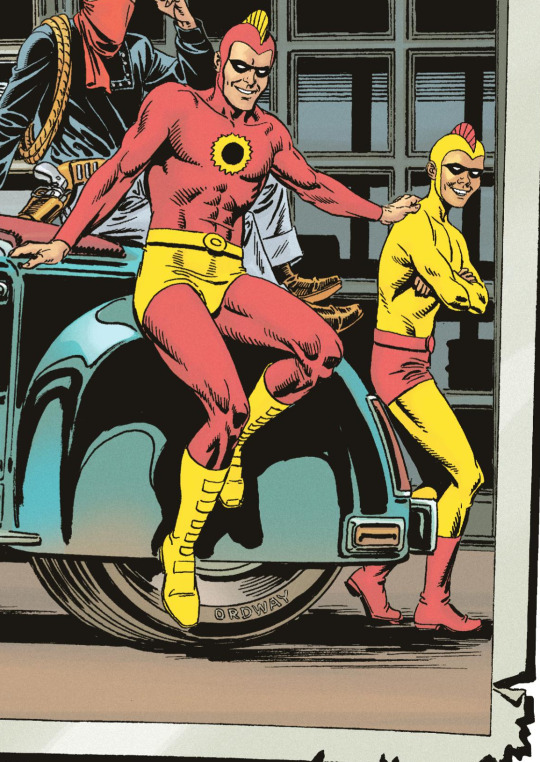
(Crimson Avenger and his sidekick Wing in a photograph taken by the Seven Soldiers of Victory, circa 1944)
Born in Hankou, in modern day Wuhan sometime in the mid 1920s, Wing How fled to America just before the outbreak of hostilities between China and Japan. Having no means of supporting himself despite his young age he took any work he could find, eventually ending up the valet of newspaper magnate Lee Travis.
Travis, a failed veteran of the early stages of the Spanish Civil War by the time he and How met was disconnected from politics despite his resources as the young owner of the Globe Leader newspaper. Travis, for lack of anyone else to talk to, began to confide in How who in turn pushed Travis to use his resources for the sake of the war in Asia.
In fact, it was a charity benefit masquerade partially sponsored by Travis whose robbery during the often mythologized War of the Worlds incident (though whether the incident itself or Travis' part within it is the more overblown in popular consciousness is hard to say) inspired Travis to fully commit himself to the garb of the Crimson Avenger.
Serving as a confidante from day one, How was never fully on board with the more harsh and violent style of intervention that Travis originally preferred, attempting to once again steer his friend and boss onto a more socially conscious course. It wasn't until Travis was moments away from executing an innocent Chinese immigrant that How fully stepped between his mentor and the problem.
Deciding to fully join his mentor on the streets, Wing's public introduction was most likely the inspiration for the Avenger's rather drastic costume change around the time of the Seven Soldiers' foundation.
The role of How is often overlooked for two equally tragic reasons.
The first being that in contemporary sources he is often heavily caricatured in line with Western depictions of Chinese people. With huge buck teeth, squinty eyes and his natural accent corrupted into something from a minstrel show.
The second being that he predeceased his mentor by some considerable margin, giving his life in battle against the Nebula Man for the sake of his teammates and the Justice League.
His personal effects are, to this day, held in trust by the Justice League alongside the effects of his mentor both in recognition of their status as the spiritual seed the League is grown from and How's personal sacrifice for the League.
#dc#dcu#dc comics#dc universe#superhero#comics#tw unreality#unreality#unreality blog#ask game#ask blog#asks open#please interact#crimson avenger#lee travis#wing#wing how#worldbuilding
39 notes
·
View notes
Text
Introduction post <3
I'm still a beginner in this (and to be fair I still hesitate in calling myself a helpol) but here goes nothing! this blog is to (mostly) post about my own experiences and talk about random stuff related to my religion :D
I'm currently devoting myself to Lord Hermes and I worship King Poseidon and have just begun worshipping Lord Thanatos :') of course there are many other deities I'd love to worship but I don't want to push it too hard just yet TT that doesn't mean I don't have devotional acts for other deities hehe
About me!
You can call me Dan :p My pronouns are she/he and I'm a 19 y/o majoring in Professional Translation and Interpreting. Aside from my mother tongue, which is Spanish, I know English and am currently studying Chinese as well. As for my interests, anything that has to do with Greek mythology. That includes Hades (game) and Epic the Musical :D I also enjoy watching anime in my free time and playing other games
I'm a bit of an introvert, but I actually do enjoy making friends so don't hesitate to talk to me ^^
I think that's it for now. Thank you for reading!
#i just realized i forgot my intro post#pls be nice to me or ill cry#hellenic community#hellenic polytheism
25 notes
·
View notes
Text
Ok, Childe as a wuxia/xianxia trope. It's honestly a bit embarrassing how well this fits.
(blame @a-yarn-of-purple-prose for this post and if anyone here is a wuxia fan feel free to correct me, I'm new to the genre)
Wuxia is a Chinese martial arts fantasy genre you are all familiar with. An adjacent genre is called xianxia, "immortal heroes", it ramps all the fantasy elements up to eleven and skews tropes a bit (we'll get back to that).
A common trope is some kind of unorthodox school/sect or technique, allowing to achieve greater power without the usual decades of training. It could be straight-out evil or just revolving around chaos.
Such a martial school is usually called an evil/demonic sect (sect is more like a clan in that setting, not the modern concept of sect) and their techniques tend to drive practitioners to insanity. Either because they are inherently corrupting or because getting too much power without growing as a person is really not the best thing for your mental health. They are also often cast from hp points.
And then there's the archetype of a demonic sect heir. The best pupil or simply someone who has inherited a lost art. Proud, always greedy for more strength, often noble in some weird way.
*points to our calamity of a boy*
Common elements of such stories include:
Falling into some weird realm or meeting a weird person who teaches the hero a Forbidden Technique
Learning a technique too quickly through some sort of magic/alchemy/memory manipulation
Some people are so singular in their pursuit they become insane (走火入魔)
Ambition bad, loyalty and family good
Conflicting loyalties, generally a conflict between a chosen path and personal weaknesses/attachments (could be both ego and familal love, and this is more of a xianxia trope)
Fits like a horoscope so far but wait.
There's a very interesting case of Korean murim genre (their version of wuxia) where sects are less varied (I recommend this post for a basic introduction) and we get three paths:
Justice/Righteous/Orthodox/Light — theoretically they keep the Evil Faction at bay, and protect innocent people, but usually are corrupt to the core
Evil/Unorthodox/Dark — these try gaining as much power as possible and attempt ruling the whole world
Demonic Cult — usually dont take part in evil and justice battles, follow their own code of conduct based on their religion, value strength above all else.
(I'm sure there's a similar distinction in wuxia too, I just can't find it in the deluge of lore)
"Demonic" is closer to "pagan" or "heathen" than Christian idea of demonic here, their beliefs are often based on Zoroastrianism and worshipping a sacred flame. Do you remember all the Persian themes used for Khaenri'ah? And Surtalogi being the flame on Surtr's sword in Norse mythology. I also had the impression that Genshin gnostic references are based on the Zoroastrian-flavoured branch of Gnosticism.
In murim the trope of demonic sect heir is called "heavenly demon" (I believe, a more correct translation would be "supreme heathen"), they are utterly badass, live for the glory of battle, seem more like forces of nature and follow a very strict honour code often conflicting with normal human ethics.
(do I need to spell it out)
TvTropes also says this about Korean stories:
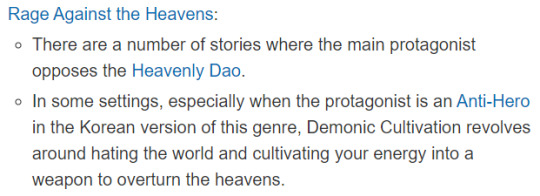
(do I need to spell it out pt.2)
I'm not sure why a Chinese studio would focus on the Korean version of this trope but I'm sure something like this exists in China as well or maybe there's a popular manhwa that inspired authors.
Xianxia extends the fantastic element further, focusing on Taoist concepts and practices and adding all kinds of magical realms (celestial, demonic, etc) and magical beings and making immortality achievable. I still need to read more about it but if I understand that right, demonic heir trope turns into a demon prince in this case. An actual visitor from the demon realm or a practitioner who achieved immortality through dubious means.
These are fae-coded in a way very similar to Childe and have a certain nonchalance towards things most humans would consider traumatic. They are simply not bothered by them, having a different set of morals or faring from a realm that is much worse.
Our boy isn't that (he's still very much human) but he's aesthetically coded like one, same as Scaramouche is yokai-coded, despite not being a yokai.
So. When people say Childe's arc is a reference to Journey to the West, it's not entirely untrue, JttW is the classic of xianxia genre and Childe does belong to the same genre. He, however, is not Sun Wukong but a different, darker trope.
This also explains why he has that "shonen anime protag but not quite" vibe. Shonen was heavily influenced by wuxia but this trope never quite made it to anime or maybe never became popular enough. It's not a deconstruction, it's a different story. Or perhaps a deconstruction of that different story.
#childe#tartaglia#wuxia#my investigation into what the hell this boy is is concluded#this means I'll get to think about something else#many thanks to saoki for indulging my questions for the past two days#there's also an argument for childe being a demon princess rather than a prince but I'm tired#maybe I'll get back to it if anyone wants to meme together#genshin lore tumour#skirk#khaenri'ah#if abyss be thy name I pledge to you my loyalty#I'll need another post to explain how it fits into some scenes#this is already too long
122 notes
·
View notes
Text

The Three-Eyed Warrior: Unpacking the Origins and Evolution of Tien Shinhan
Tien Shinhan, the stoic, three-eyed martial artist, stands as a pillar of the Dragon Ball universe. From his initial antagonistic role to his unwavering dedication to Earth's defense, Tien's journey is a testament to perseverance and self-improvement. But where did this unique character come from, and how has he changed over the years? Let's delve into the fascinating origins and evolution of Tien Shinhan.
A Divine Inspiration: The Roots of Tien's Design
Akira Toriyama, the mastermind behind Dragon Ball, often drew inspiration from various sources, including Chinese mythology and folklore. Tien Shinhan's design and abilities are heavily influenced by Erlang Shen, a powerful three-eyed deity from the classic Chinese novel "Journey to the West." Erlang Shen, like Tien, possesses a prominent third eye, granting him enhanced vision and mystical powers. Both characters are renowned martial artists, initially serve as adversaries to the protagonist (Sun Wukong in "Journey to the West" and Goku in Dragon Ball), and eventually become respected rivals and allies.
While the Erlang Shen connection is clear, it's important to note that Toriyama's creative process is a melting pot of influences. He often combines different elements and adds his own unique spin, resulting in characters that are both familiar and refreshingly original.
From Rival to Respected Ally: Tien's Journey Through Dragon Ball
Tien's introduction in the original Dragon Ball series paints him as a formidable antagonist. Initially a student of the Crane Hermit, he embodies a ruthless approach to martial arts, even breaking Yamcha's leg during the 22nd World Martial Arts Tournament. His third eye, initially portrayed as a sign of his dark nature, adds to his intimidating aura.
However, Tien's character arc takes a significant turn. His battles with Goku, particularly during the Fortuneteller Baba saga and the 22nd World Martial Arts Tournament, spark a transformation within him. He witnesses Goku's unwavering spirit and commitment to justice, leading him to question his own path. Tien eventually renounces his master's teachings and embraces a more honorable code of conduct.
From this point forward, Tien becomes a valuable member of the Z Fighters, consistently training to improve his skills and protect Earth. He plays a crucial role in various battles, notably against the Saiyans, Frieza, and Cell. While he may not always be at the forefront of the action, his unwavering dedication and strategic mind make him an indispensable ally.
Beyond Power: Tien's Evolution in Dragon Ball Super
In Dragon Ball Super, Tien continues to demonstrate his commitment to martial arts and self-improvement. While he acknowledges that he can't compete with the Saiyans' ever-increasing power levels, he focuses on honing his own techniques. He establishes his own dojo, teaching students and passing on his knowledge.
Perhaps the most significant aspect of Tien's evolution in Super is his role as a mentor and teacher. He imparts valuable lessons to his students, emphasizing the importance of discipline, focus, and inner peace. This reflects his own journey of self-discovery and his understanding that true strength lies not just in physical power, but also in mental fortitude.
Tien's character development highlights the themes of redemption, perseverance, and the pursuit of self-improvement. He represents the idea that anyone can change and grow, regardless of their past. While he may not possess the god-like power of Goku or Vegeta, his unwavering dedication and his unique set of skills make him an integral part of the Dragon Ball universe. He remains a fan favorite, a testament to his complex character and his enduring spirit.
#tien shinhan#Tien#Tien Dragon Ball#DBZ#Dragon Ball Z#Dragon Ball characters#akira toriyama#dbs#dragon ball super#tien dbz
17 notes
·
View notes
Text
Jentry Chau vs. The Underworld

Jentry Chau focuses on the titular character, a girl with pyrokinetic powers that accidentally awoke them as a child, burning her hometown. As they resurface on the eve of her 16th birthday - also the date powerful mogwai spirits want to eat her soul - she has to deal with the trauma of her past experiences, navigate her teenage life, and try to survive.
In other words, a perfect and largely original (barrig romantic clichés) Chinese urban fantasy series. It is a good introduction to Chinese mythology and its various supernatural entities, accompanied by a hip and kpop soundtrack and a pleasant, almost comic-book like animation style.
A solid reccomendation
35 notes
·
View notes
Text
The real life inspirations behind new characters in Touhou 19 (Unfinished Dream of All Living Ghost) While I haven’t been posting much about Touhou as of late, I felt obliged to put together the customary post about the inspirations behind the new characters. The new game genuinely renewed my interest. In contrast with similar write-ups pertaining to previous games the research is not entirely mine - some of the sections are a result of cooperation between me and @just9art. Without further ado, let’s delve into the secrets of the new cast. Find out if Biten is the first “Wukong impersonator” ever, when a tanuki is actually a badger, and why Hisami both is and isn’t an oni. Naturally, the post is full of spoilers. Also, fair warning, it's long.
1. Biten Son - sarugami + Sun Wukong
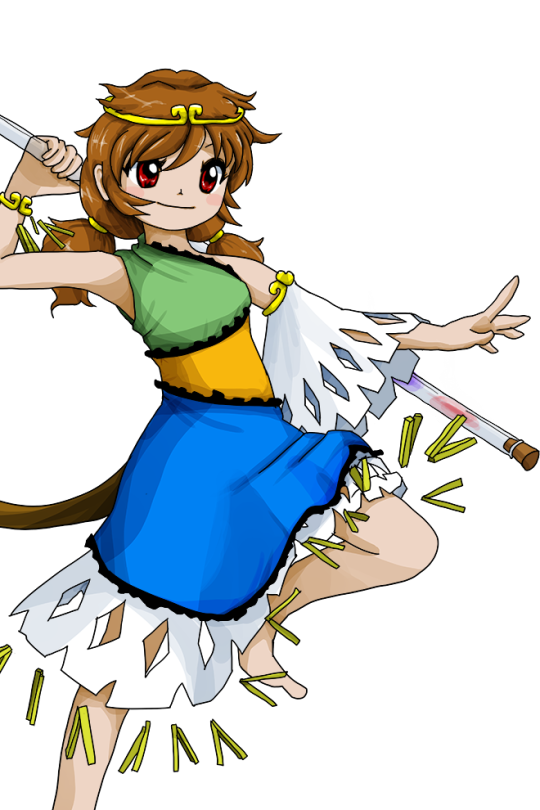
Sarugami means “monkey kami”, the monkey in mention being the Japanese macaque.To my best knowledge, the term is actually not used commonly in English - the results on jstor and De Gruyter are in the low single digits, Brill outright has nothing to offer. Translations are much more common.
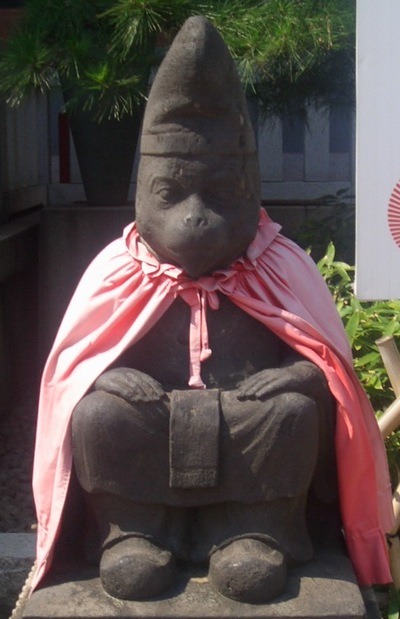
Sarugami are particularly strongly associated with Mount Hiei. You might have heard of it because of its association with Matarajin, though in this case he’s not exactly relevant. Instead, it is believed the monkeys act as messengers of Sanno (the “mountain king”), Sekizan Myojin and Juzenji. Sanno himself could take the form of a monkey according to medieval texts, while Juzenji can be accompanied by a deity depicted as a man with a monkey’s head, Daigyoji, known from the Hie mandala. Sarutahiko is also associated with monkeys based on the similarity between his name and the word saru. Bernard Faure notes that despite the clearly positive portrayal of monkeys as semi-divine beings in service of these deities, their perception in folklore and mythology can nonetheless be considered ambivalent, because they could be viewed as aggressive. There are even examples of sarugami being portrayed as monstrous antagonists to be defeated by a hero. The best known tale of this variety is known simply as Sarugami taiji. It is preserved in the Konjaku monogatari. Here the sarugami is a fearsome monster who terrorizes a village and demands the offering of one young woman each year.
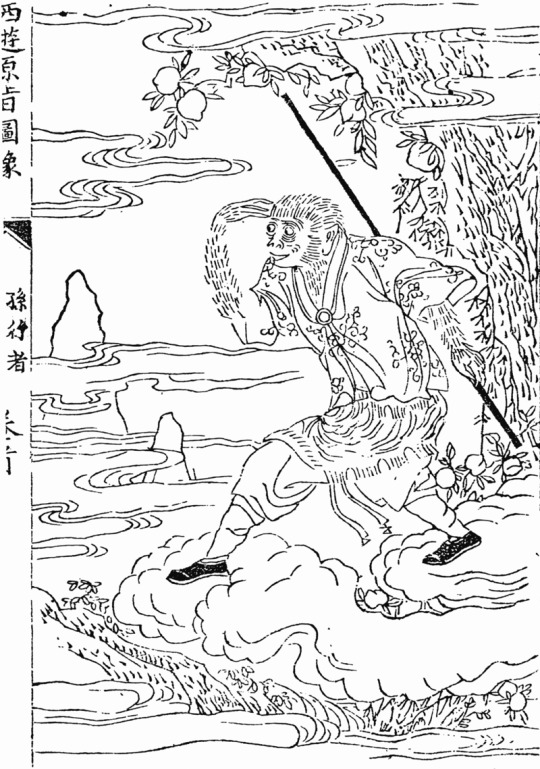
In contrast with the sarugami, I do not think Sun Wukong, one of the protagonists of the classic Chinese novel Journey to the West, needs much of an introduction. We reached the point where even in the west he is recognizable enough to warrant toys based on him (there’s a Lego Wukong on my desk right now). Biten's design has many callbacks to traditional portrayals of Wukong, including the staff (which in the novel is a pillar stolen from the undersea palace of a dragon emperor) and a very distinctive diadem (in the novel making it possible to pressure the unruly Wukong into obeying the monk he is meant to protect). As a curiosity it’s worth noting that “fake Wukong” is not a brand new idea - in the novel itself, one of the enemies of the heroes, Six-Eared Macaque, actually impersonates him for a time. Wukong is effectively himself a “divine monkey”, seeing as despite his origin as a literary character he actually came to be worshiped as a deity in mainland China, Taiwan and various areas with a large Chinese diaspora. The topic of Wukong worship itself came to be an inspiration for literature, starting with the excellent The Great Sage, Heaven’s Equal by Pu Songling, a writer active during the reign of the Qing dynasty, in the early eighteenth century.
2. Enoko Mitsugashira - “immortal yamainu” + Cerberus
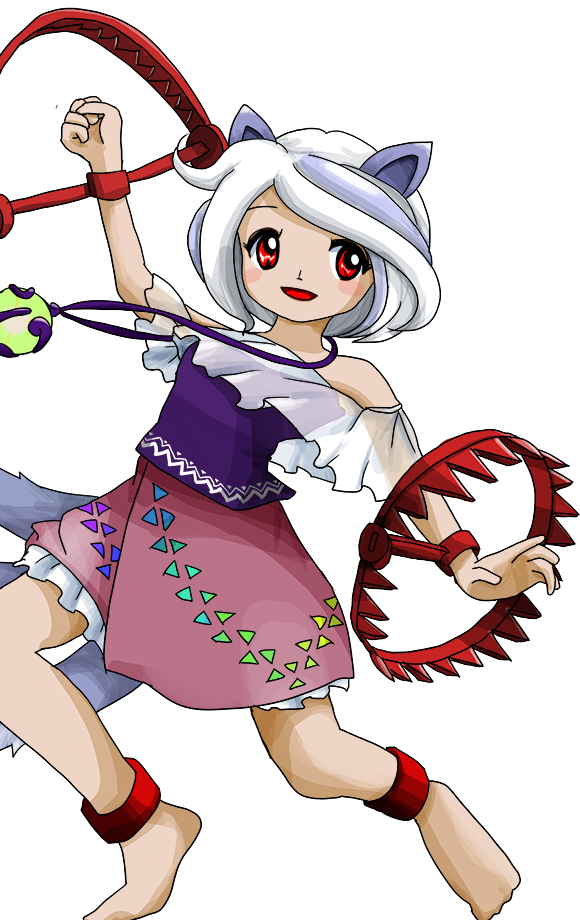
Enoko gets the least coverage here, because there really isn’t much to say. Yamainu, “mountain dog”, isn’t really a supernatural creature, it’s an old term for either the extinct Japanese wolf, a type of feral dog, or a hybrid between these. It can also be used as a synonym of okuri-inu, a youkai wolf believed to accompany travelers at night.

There’s actually a distinctly Journey to the West-esque component to Enoko’s backstory, but I have no clue if this is intentional. In the aforementioned novel, many of the antagonists, who are generally demonic animals, are motivated by the desire to devour the flesh of the protagonist, the Buddhist monk Tang Sanzang, because it is said to grant immortality. Granted, given the obscurity of the figure Zanmu is based on - more on that later - perhaps this is an allusion to something else we have yet to uncover. Cerberus, being probably one of the most famous mythical monsters in the world, does not really need to be discussed here. The illustration is included mostly because I like Edmund Dulac and any opportunity is suitable for sharing his illustrations. I do not think it needs to be pointed out that Enoko's bear trap weapons are meant to evoke Cerberus' extra heads.
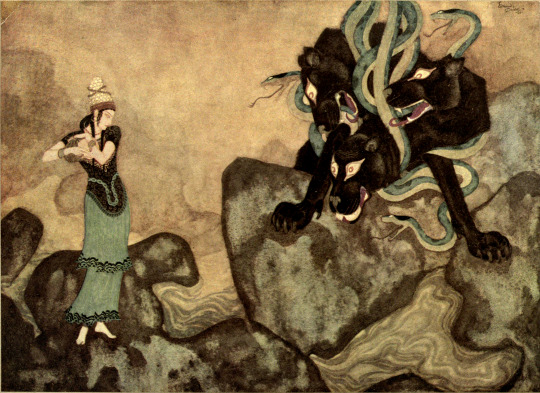
3. Chiyari Tenkajin - tenkaijin (+ mujina) + chupacabra
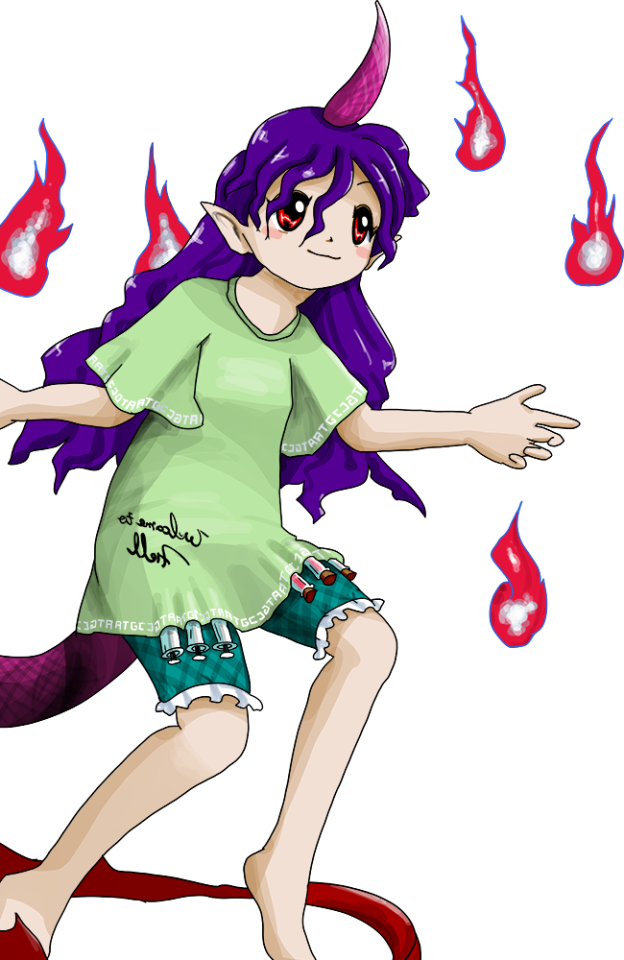
While my favorite animal youkai not yet featured in Touhou is easily the kawauso (otter), I was very pleased to learn we sort of got a mujina since I wanted to cover this topic since forever, but never got much of a chance. Technically Chiyari is actually meant to be a tenkaijin, which is not a mujina but a slightly different youkai (a will-o-wisp or St. Elmo’s fire-like creature, specifically) who in the single tale dealing with it takes the form of a mujina after dying, but as there is not much to say about it beyond that you will get a crash course in mujina folklore instead.

Today the word mujina is pretty firmly a synonym of anaguma - in other words, the Japanese badger. The animal does not substantially differ from other badgers, so I do not think much needs to be said about its ecology. However, historically the term could be used to refer to the tanuki regionally, or interchangeably to both animals, so in some cases if insufficient detail is provided it is hard to tell which one is meant. This ambiguity extends to the folklore surrounding them, and generally if you know what to expect from tanuki tales, which I’m sure most people reading this do, you will instantly recognize many of the plot elements typical for mujina ones. In other words, it is yet another yokai which typically takes the role of a shapeshifting trickster. Some supernatural phenomena could be basically interchangeably attributed to mujina, tanuki, kitsune or kawauso. Mujina are commonly described taking the form of Buddhist monks, which is one of the many similarities between them and tanuki.
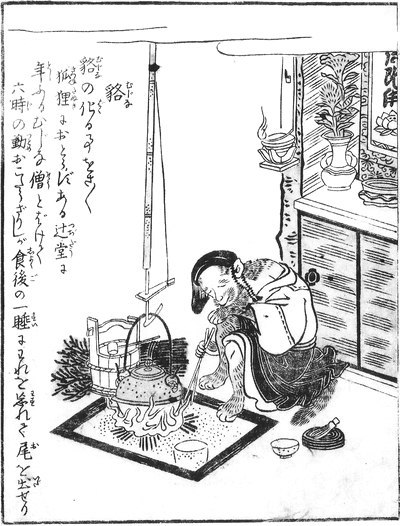
The most famous depiction of a shapeshifting mujina comes from Toriyama Sekien’s Konjaku Gazu Zoku Hyakki (The Illustrated One Hundred Demons from the Present and the Past). The accompanying text compares the creature to the supernatural versions of kitsune and tanuki, and states that the artist relied on a tale according to which a mujina was able to successfully impersonate a Buddhist monk until accidentally revealing its tail.
What makes the mujina special is that it is actually the oldest recorded example of a youkai of this sort. A mujina tale already appears in the early Japanese chronicle Nihon Shoki, dated to 627. It reports an incident of a mujina transforming into a human and singing somewhere in the Michinoku Province. I feel like this alone is a good example of why you should be wary of people who seek to present Nihon Shoki or Kojiki as historical truth. Western audiences as far as I know were first introduced to mujina by Lafcadio Hearn. To my best knowledge, the fabulous shapeshifting badgers however failed to gain the popcultural recognition enjoyed by tanuki and kitsune. They did appear in Shigeru Mizuki's stories every now and then, and I found a mascot character based on them, but overall there isn't all that much beyond that.
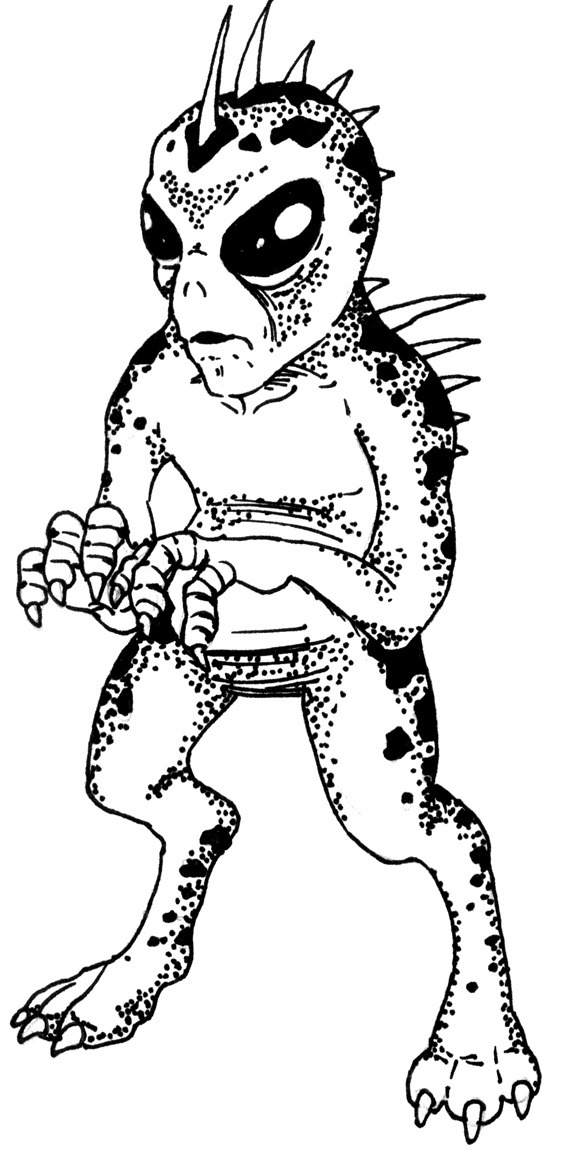
Naturally, there isn't much mujina in Chiyari's design, and she instead most likely owes her distinctly spiky appearance to the other inspiration behind her character, the chupacabra. Mujina are not really portrayed as bloodthirsty, but the poorly documented tenkajin apparently is, which is presumably why ZUN decided to connect Chiyari with the chupacabra, the best known modern blood-drinking creature, who first appeared in tall tales from 1995 and subsequently took popculture by storm after spreading from Puerto Rico to mainland USA and Mexico. I am not a chupacabra aficionado so I have little to offer here, sadly.
4. Hisami Yomotsu - yomotsu-shikome
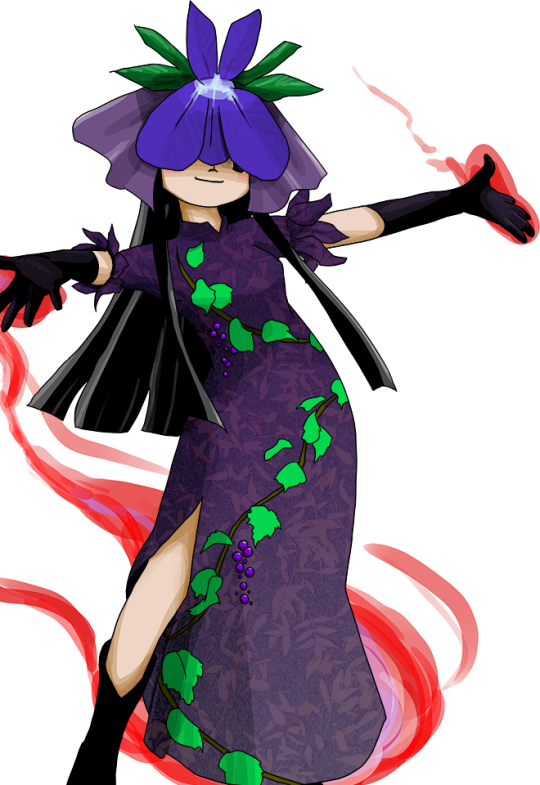
Judging from what I’ve seen on social media and on pixiv, Hisami is shaping up to be one of the most popular new characters (she’s my fave too). In sharp contrast with that, her basis is pretty obscure. So obscure that there isn’t even any historical art to showcase, as far as I can tell (note that this blog claims night parade scrolls might have something to offer, though - I was unable to verify this claim for now, sadly). As we learn from her bio, she is supposed to be a yomotsu-shikome. They’re called the “hags of Yomi” of Yomi in Donald L. Philippi’s Kojiki translation. The term shikome can be literally translated as “ugly woman”. Nothing about them really implies femme fatale leanings we are evidently seeing in Touhou but I’m not going to complain about that. Yomotsu-shikome appear only in the Kojiki and the Nihon Shoki, and in both of these early chronicles they are portrayed as servants of Izanami after she died and came to reside in Yomi, the land of the dead. Nihon Shoki states there are only eight of them. The distinct grape vine motif present on Hisami’s clothes seems like an obvious reference to Izanagi’s escape from Yomi following his meeting with Izanami, portrayed in the myth recorded in both of these sources. When the yomotsu-shikome started to pursue him, he threw a vine he used to hold his hair at them. The plant instantly bore fruit, which the entities started to eat. They later resumed the chase, but were once again held back, this time by a bamboo shot. According to the Nihon Shoki, they eventually give up after he creates a river from his piss (sic) to keep them away.
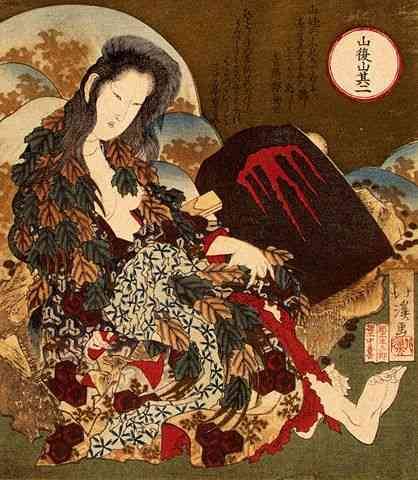
Yomotsu-shikome are sometimes compared to oni by modern researchers. Noriko T. Reider in her monograph about oni argues that alongside hashihime and yamanba (pictured above) they can be effectively grouped with them. Another researcher, Michael D. Foster, is more cautious, and states that despite clear similarities it’s best to avoid conflating oni-like female demons with female oni proper, especially since the latter have a distinct iconography and a distinct set of traits. Norinaga Motoori, the founder of kokugaku or “national learning”, a nationalist intellectual movement in Edo and Meiji period Japan, claimed that oni were based on yomotsu-shikome, which is a pretty dubious claim. It is ultimately not certain when the term oni started to be used, but it is safe to say it has continental origin. And, of course, oni permeate Japanese culture in a way yomotsu-shikome do not.
5. Zanmu Nippaku - Zanmu
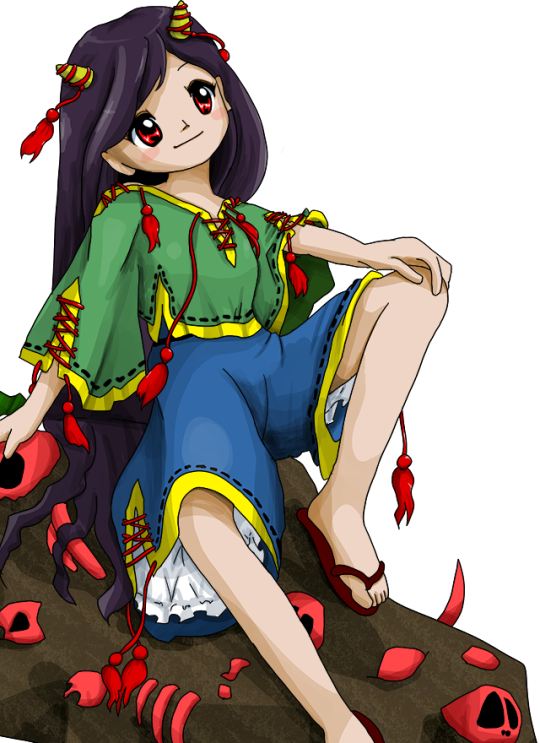
This was the toughest mystery to solve, and I am fully indebted to 9 here, since they figured it out, I am merely depending on what they directed me to. Research is still ongoing, and it feels like we just started to untangle this mystery, so you can safely expect further updates. Zanmu appears to be based on the Buddhist monk… well, Zanmu. You can learn a bit about him here or on Japanese wikipedia; it seems there are quite literally 0 sources pertaining to him in English, and even in Japanese there is actually very little. Their names are not written the same, ZUN swapped the sign for “dream” from the original name for one which can be read as “nothingness”. If the unsourced quote on wikipedia is genuine, the reason might be tied to the personal views of the irl Zanmu. What little we’ve been able to gather about him is that he was active in the Sengoku period, and apparently was regarded as unorthodox and eccentric. This lines up with Zanmu’s omake bio pretty well. Seems the real Zanmu was also unusually long lived, and was able to recall events from distant past in great detail, though obviously the figure of 139 years attributed to him in a few places online has to be an exaggeration.
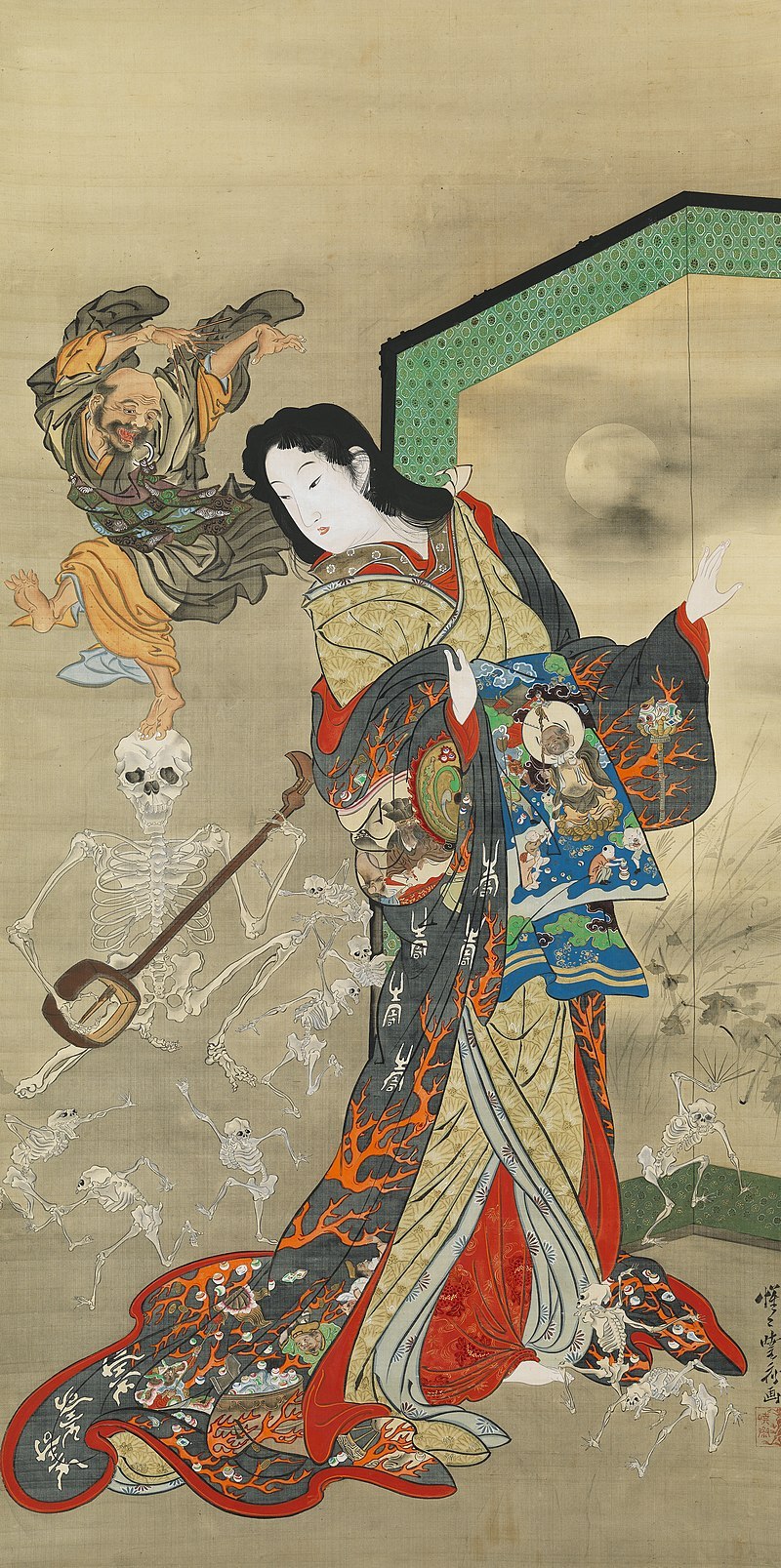
Yet more puzzling is the reference to Zanmu’s familiarity with Ikkyo you might spot in the linked article. Whether the famous Ikkyo who you may know from the tale of Jigoku Dayu is meant is difficult to determine. The chronology does not really add up; on the other hand the logic behind associating one eccentric semi-legendary monk with another in later legends isn’t particularly convoluted. As 9 pointed out to me, if ZUN was aware of this link, and the same Ikkyo really was meant, it is not impossible the connection between Zanmu and Hisami is meant to in some way mirror that between Ikkyo and Jigoku Dayu. As you can easily notice, it’s pretty clear the historical Zanmu was male. It does not seem his Touhou counterpart is, obviously. I would say we should wait for more info until declaring that we have a second Miko situation on our hands, with a male historical figure directly reimagined as a female character without any indication we are dealing with a relative rather than the real deal. There’s still relatively little info to go by so I would remain cautious (though naturally this is not meant to discourage you from having headcanons).
Neither me nor 9 were able to find any connection between the historical Zanmu and oni… so far, at least. Therefore, what motivated ZUN to make Zanmu an oni remains to be discovered. As a final curiosity, on a semi-related note it might be worth pointing out that while not as common as their male peers, female oni are not a modern invention, and already appear in setsuwa from the 13th century. A particularly common motif are tales describing a woman turning into oni due to jealousy or anger. Further reading:
Jason Colavito, The Secret Prehistory of El Chupacabra (2011)
Bernard Faure, Gods of Medieval Japan vol. 1-3 (2015-2022)
Michael Daniel Foster, The Book of Yokai. Mysterious Creatures of Japanese Folklore (2015)
John Knight, Waiting for Wolves in Japan. An Anthropological Study of People-wildlife Relations (2003)
Noriko T. Reider, Japanese Demon Lore (2010)
279 notes
·
View notes
Text
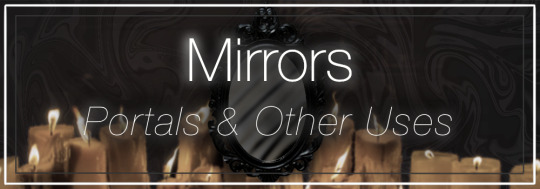
Title: Mirrors: Portals and Uses
Recommended Reading
Altars: Uses & Design Dimensions & PlanesDualities in Witchcraft Researching Witchcraft Spiritwork: First Steps Basics of Spellcasting Basics of Warding Basics of Banishing Energy Work Fundamentals Intermediate Energy Work The Subtle Body The Wellsource Correspondences: Research, Creation, & Use
Please note that some information on this post comes from personal experience as well as conversations with my elders and other practitioners.
Introduction
Mirrors harbor a unique and paradoxical role, often existing at the intersection of clarity and obfuscation. Throughout the annals of history, these reflective surfaces have been the subject of mystic fascination and contemplation. Shrouded in a mysterious aura, mirrors are an integral component of various mystical practices across diverse cultures.
A seminal instance is observed within the African Yoruba tradition, where mirrors are emblematic of Oshun, the deity of beauty, love, and prosperity. Here, these reflective surfaces serve as conduits to divine insight, manifesting the ethereal into the perceptible. Parallel to this, in the indigenous cultures of the Amazonian Shipibo-Conibo people, mirrors - often represented by reflective surfaces of water - are perceived as gateways to understanding the complex layers of the universe, thus embodying a significant spiritual tool. Moreover, in many East Asian practices, mirrors carry deep symbolic significance and are fundamental in rituals aiming to ward off malevolent forces. Among the Ainu people of Japan, for instance, mirrors function as amulets, protecting the holder from supernatural harm.

Mirrors as Portals
A ubiquitous yet perplexing facet is the concept of mirrors functioning as portals. These reflective surfaces, more than mere decorative elements or vanity tools, hold a quintessential place in mystic and magical practice, extending beyond their ordinary use to become intermediaries between the unknown and the practitioner. Diving into the understanding of mirrors, one might read about their role as gateways. The duality of mirrors, both reflective and transparent, presents a tantalizing paradox: what they display isn't a mere reflection, but an alternate universe or spiritual plane. This dichotomy positions mirrors as a connective threshold, an aperture between the observable and the unknown, the physical and the mystical. Despite their allure, mirrors necessitate careful handling within a magical context. It is a common misconception that mirrors only function as portals during explicit rituals. However, their latent potential as conduits should not be overlooked. Consequently, it's paramount that mirrors remain shrouded or safeguarded within consecrated spaces to prevent inadvertent connections to unwelcome energies. Approaching this aspect with a measure of respect and precaution is instrumental in maintaining the equilibrium of such spaces.
Historically, the mirror's role as a portal is discernible across a myriad of cultural contexts. In Greek mythology, Narcissus fell victim to his reflection in a pool of water, demonstrating an early symbol of mirrors as deceptive portals to the ego. In Chinese folklore, the mythical creature Nüwa repaired the heavens using a seven-colored stone, comparable to a mirror, again associating these reflective surfaces with cosmic transitions.
Mirrors often represent truth, knowledge, and self-awareness, owing to their reflective properties. However, their potential as portals imbues them with added dimensions of mystery, transformation, and transition. The mirror, in this context, becomes a metaphor for change and personal evolution, presenting a liminal space where the known meets the unknown, thereby offering new possibilities and perspectives.
Given the energetic properties inherent in mirrors, they should always be treated as portals. Their constituent materials - silica and silver - interact in such a way that a subtle, yet potent, energetic field is generated, a field potentially capable of bridging multiple planes. To ensure safety, mirrors should be handled with respect and caution. They should be appropriately covered or warded when not in use, especially within sanctified spaces. It is also recommended to cleanse mirrors regularly to reset their energetic state and prevent any residual energies from accumulating.
Energetic Interactions & Metaphysics
Energetic Interactions
Amid the energetic symphony of the universe, each object reverberates its unique energetic signature, contributing to the collective composition. Mirrors, with their paradoxical and captivating nature, have often been the center of esoteric investigation. This intrigue is rooted not only in their physical attributes but also in their nuanced energetic interactions.
To comprehend the energetic interplay of mirrors, one must first examine the properties of its constituent components. Primarily, mirrors are composed of glass, a substance formed from the supercooling of molten silica into a quasicrystalline structure. Coating the back of this silica-based surface is a thin layer of reflective metal, usually aluminum or silver.
Silica is very insulative, and negentropic, meaning that its natural energetic state eventually resets regardless of influence. It is also Attractive, meaning that it slowly pulls other energetic compounds to itself. Due to the quasicrystalline structure, glass is refractive and enthalpic, meaning that it becomes thermal under pressure- or releases energy. Silver is conductive and repulsive in nature. Due to how silver atoms prefer to arrange themselves (a face-centered cubic lattice) it also tends to be very metastable, meaning that its natural energetic state is not prone to change regardless of energetic interactions. Because the two are constantly next to each other, because of the silver backing, the negentropic nature of the silica causes an energetic cycle of attraction and repulsion, this oscillation combined with the conductive nature of silver and the entropic nature of glass generates a small energetic field. While this is normally negligible, it creates the perfect environment for the propagation of connections between spaces or planes that are out of phase with our own.
The unique composition of mirrors implicates a distinct effect on the ambient energy. Mirrors, with their inherent vibrational resonance, can both pull and push energy, thereby influencing the surrounding energetic atmosphere. The capacity of mirrors to manipulate energy finds practical applications in the sphere of spellwork and energy transmutation. Through their reflective properties, mirrors can serve as effective tools in spells that involve redirection or amplification of energy. They can be used to create energetic boundaries, return energetic influences, or focus and multiply ambient energy and energetic projections.
Common Metaphysics of Mirrors
The mirror, with its intrinsic capacity to reflect, serves as a potent symbol of the Jungian 'Shadow' - the hidden aspects of one's psyche that are often suppressed or ignored. Through the act of looking into a mirror, one is invited to confront and acknowledge these facets, facilitating a journey towards holistic self-awareness. The mirror, in this respect, catalyzes self-reflection and introspection, propelling an individual towards self-understanding and acceptance. Delving into the sphere of mirror magic uncovers its profound connection to personal transformation. The reflective nature of mirrors encapsulates the principle of change, embodying the potential for alteration and transformation. As such, mirror magic can be utilized as a tool for self-development and evolution, offering a means to focus energy towards constructive change. Beyond symbolism and transformation, the metaphysical properties of mirrors warrant exploration. Mirrors, by their construction and function, are potent energetic entities. The amalgamation of silica and metallic elements results in a unique vibrational resonance, enabling the mirror to absorb, store, and emit energy. This energetic characteristic, coupled with the mirror's reflective capacity, amplifies its metaphysical potency, making it an influential tool in various mystical practices. Moreover, the reflective nature of mirrors aligns them with the principle of 'as above, so below', a concept found in various esoteric traditions. This principle speaks to interconnectedness, suggesting that what occurs on one level of reality also happens on another. Mirrors could, therefore, serve as a solid physical replacement for any correspondence necessary.

Divination, Spells, & Ritual
In the enigmatic arena of divination, mirrors command a distinctive presence. Among various techniques, scrying - the act of gazing into a reflective surface to perceive spiritual messages - emerges as a common method of introspection and foreknowledge. This practice unfolds as a tripartite process, encompassing the scrying ritual, technique, and subsequent interpretation.
Scrying, an ancient form of divination, leverages the reflective properties of reflective surfaces, like mirrors, to delve into the psyche, unveil hidden knowledge, or prognosticate future events. This technique transcends conventional sensory perception, engaging instead with subconscious and/or spiritual entities. The mirror functions as a medium, harnessing and focusing the widened attention in order to project images or symbols onto the reflective surface. These visual constructs carry messages from the spiritual domain, providing insights that range from self-understanding to predictive revelations.
Techniques & Rituals for Scrying
Executing mirror scrying necessitates a meticulous approach. Often, the process commences with the preparation of the space and the individual. Creating a tranquil environment, devoid of disruptive elements, facilitates a deeper, unhindered connection with the spiritual plane. Personal preparation includes grounding and centering exercises to align the individual's energy with the ambient energy of the environment. They then place a light source between them and the reflective surface. Once prepared, the practitioner enters a meditative state, allowing their gaze to soften and unfocus while looking into the mirror. This passive observation invites subconscious impressions to surface and be displayed on the mirror. Maintaining an open mind and a receptive state is crucial, as the visions or symbols may not be immediately clear or might require subsequent interpretation.
Interpretation of Images & Symbols in Reflections
Post the scrying experience, the practitioner embarks on the task of interpreting the observed symbols or images. This phase is intrinsically subjective, as the significance of the symbols often rests within the personal context of the observer and their held convictions and correspondences. However, there are common archetypes and symbols that carry collective meanings, which can provide a starting point for interpretation.
For instance, water-themed images might signify movement, emotions, or the unconscious, while an image of a bird might symbolize freedom or spiritual elevation. However, these interpretations are not rigid, and the practitioner must trust their intuition to derive the true message from the symbols. Being able to pull specific concepts from abstraction can be an invaluable tool in this practice. Moreover, it's worth noting that the absence of specific images during scrying does not indicate failure. Sometimes, the experience might be more of an energetic shift or a feeling, which are equally valid forms of divinatory communication.
Examples of mirror spells for different applications
Harnessing the power of mirrors, one can devise a multitude of spells tailored for diverse purposes. One such example pertains to protection, where a mirror can serve as a shield to deflect negative energy. Here, the mirror is positioned facing outward, symbolically repelling unwanted influences, thereby safeguarding the individual or space.
Another practical application can be found in the realm of healing. A mirror, due to its reflective nature, can be utilized to channel and focus healing energy towards a specific target. For instance, an inscription or symbol associated with health could be drawn on the mirror surface. Subsequently, this healing symbol is then "activated" by focusing one's concentration on it, allowing the mirror to magnify the healing intention.
Mirror spells also prove instrumental in the domain of self-improvement. One may write or speak affirmations into a mirror, thereby employing its reflective capability to reinforce positive change. The mirror's surface serves to amplify the affirmation, aiding in its internalization and materialization.
Ritual Practices Involving Mirrors
Mirrors, acting as tools for focus, protection, and transformation. One common ritual involves the use of a mirror as a portal for spiritual communication. In this practice, the mirror is treated as a gateway, a connection point between the physical and spiritual planes. Practitioners may engage in meditation or trance work in front of the mirror, seeking to establish communication with spiritual entities or access deep layers of the subconscious.
Another ritual entails the use of a mirror in a consecration ceremony, where the mirror is "cleansed" of any residual energy and "charged" with a specific purpose. This process involves elements like incense, candles, or natural elements like moonlight, leveraging their specific energetic signatures to cleanse and empower the mirror.
One must, however, proceed with caution when interacting with mirrors in a ritualistic context. Given their potent properties, mirrors must be handled respectfully and carefully. Always ensure that the ritual mirror is properly stored or covered when not in use to prevent any unintended energetic interactions.
Example Ritual That Incorporates Mirrors
Ritual of Mirror Reflection
Objective: This ritual aims to promote self-reflection, growth, and self-awareness. It harnesses the unique properties of mirrors to aid participants in seeing and understanding aspects of themselves more clearly.
Optimal Circumstances: Conduct this ritual during a new moon, a time known for introspection and new beginnings. A quiet, dimly lit space with minimal disturbances is ideal.
Ingredients and Correspondences:
Mirror: Acts as the primary tool for reflection and introspection
(Optional) A bowl
White Candle or electric candle: Represents purity and clarity.
(Optional) Lavender Incense: Used for relaxation and heightening awareness.
(Optional) Salt: Represents grounding and protection.
(Optional) Incense for grounding
(Optional) Offerings for your spirits
Preparation:
Create a clean, sacred space where the ritual will take place.
Place the mirror on a flat surface.
Practice the incantation until you can recall it without breaking your train of thought: “Show me, guide me, reveal the truth inside me.”
(Optional) Place the salt and lavender in a bowl and then set the candle in the bowl, cradled within the mixture to support it.
(Optional) Place the candle between you and the mirror before lighting it.
If the bowl, salt, and lavender is omitted, just place the candle between you and the mirror. Be sure that the candle is in a glass container for fire safety.
Procedure:
Creating and Engaging the Headspace:
Ensure that your space is free from distractions by turning devices off or on silent, taking measures to get pets quiet and happy, notifying other residence that you require some quiet, putting on headphones with music, and setting comfortable lighting.
Use the flame from the candle dance. Let its clarity inspire your mind to remain focused and clear throughout.
(Optional) Affirm to yourself, “Today, I seek a clearer understanding of myself.” if you think it will aid you.
Maintain this headspace by repeatedly returning your focus to the candle's flame and the points of gnosis whenever your mind wanders.
Entering a State of Gnosis:
Light the incense and take a few deep breaths, inhaling the calming scent.
Sit or stand comfortably before the mirror, gazing deeply into your reflection.
Allow any extraneous thoughts to flow out with each exhale.
Gradually move your awareness inwards on your own psyche. While maintaining equal awareness of each component, break up your psyche into subsequent parts by whatever categorization feels most optimal for you.
Include awareness of your subtle body in your gnosis, as it also plays a role in the psyche.
Take steps to ensure that your state of gnosis is unbroken throughout the spell.
Programming the Energetic Body:
Within your gnosis, move your center of consciousness into your subtle body.
Incorporate your Wellsource into your awareness and how it feeds energy into your subtle body.
Begin to radiate Wellsource energy out of each energy point radially. Be sure that the amount of energy per second is unilateral for each point.
Energetic Constructs:
While maintaining gnosis, reach out and sense the energetic properties and projections from the mirror. It should be a rapidly oscillating field that projects roughly 10 cm -1 m away from the mirror relative to its size. If you’re using a black mirror, stone mirror, or any mirror that doesn’t have a silver backing it will have a different energetic sensation.
(Optional) Incorporating Spirits:
To integrate spirits, whisper a humble request for guidance from trusted spirits and give whatever offerings they prefer. To identify them, look for sensations of warmth, a gentle pressure, or feelings of serenity.
Ensure that you do not demand, but gently request their presence.
Understand that they will help you if they desire, but do not rely on or expect their assistance.
Ritual Action:
Gaze into the mirror, allowing your eyes to defocus slightly. As you do, softly chant or whisper, “Show me, guide me, reveal the truth inside me.”
With each repetition, delve deeper into introspection, understanding the various facets of your being.
Sink your awareness into the components of your psyche. Try not to label them, and just observe them. Trust that your subconscious will bring back what it is you need from the working.
Concluding the Ritual:
Collect the energy you released and send it into the earth.
Thank your spiritual aids, if you called them, and invite them to leave.
Extinguish the candle and clear the space, ensuring to store the mirror safely.
Cleanse the space using whatever means are more comfortable to you.
Note: Always cleanse the mirror after use to reset its energetic state. This can be done by washing it with salt water or vinegar. If you’d like to seal the mirror, draw a sigil on it and/or cover it with a black or white cloth.

Spirit Work
Mirrors, in their multifaceted roles within various esoteric traditions, exhibit a powerful capacity for spirit work. This encompasses a wide spectrum of practices ranging from entity banishment to spirit communication. The exploration of these applications, while deeply intriguing, also necessitates an attitude of respect and careful handling given the potent nature of this work.
Examples of Mirrors in Use for Spirit Work
In several indigenous cultures, mirrors are employed for spirit work, acting as conduits between the physical world and the spiritual realm. For instance, among the indigenous Huichol people of Mexico, mirrors are often integrated into shamanistic practices to facilitate communication with ancestral spirits. This specific usage is chronicled in "The Huichol: A Culture Walking Towards the Light" by Susana Valadez and "Shamanism and Spirituality in Therapeutic Practice" by Christa Mackinnon.
In Asia, particularly within the indigenous Ainu community of Japan, mirrors, known as "Iyomante," are considered sacred objects that bridge the gap between humans and "Kamuy" (divine beings). Details of this practice can be found in "The Ainu and their Folklore" by John Batchelor and "Ainu: Spirit of a Northern People" by William Fitzhugh and Chisato Dubreuil.
Using Mirrors for Banishing
Mirrors also play a role in the banishment of unwanted entities. The rationale behind this practice is that the mirror's reflective surface 'returns' the entity's energy back to itself, which can prove disorientating or repelling for the entity. It can also act as a portal to another spiritual plane through which an entity can be sent to. A particular method involves placing the mirror with the reflective side facing outwards towards the direction from which the negative energy is perceived to originate. During this process, the practitioner maintains a focused state, using projections from the subtle body to direct the unwanted energy into the mirror.
Using Mirrors for Spirit Communication
The reflective nature of mirrors has led to their usage as tools for spirit communication, serving as a medium through which messages from the spiritual realm can be received. This practice often involves mirror gazing or scrying, where the practitioner enters a meditative state and focuses on the mirror's surface, inviting communication from spirits.
One notable example is the "Psychomanteum," a mirrored chamber used for contacting spirits of the departed, popularized by Dr. Raymond Moody, author of "Reunions: Visionary Encounters With Departed Loved Ones". This technique requires a carefully controlled environment and preparation to facilitate spirit communication. It's recommended for only experienced practitioners or under the guidance of a seasoned professional. It is important to note that while mirrors can be effective tools in spirit work, some methodologies may not work for everyone due their vagueness or whether they’re writing from a personal narrative.

Patreon Shoutouts!
Megan Kipp Jinsu Ing Mar Cosmicauquamarie Elizebeth T. Ash
Thank you for your continued support! My patrons help me maintain the drive to create content and help me keep food in my pantry.
My patrons of Mystic tier and higher had access to this article a week before it was public! To see other perks of supporting me, click here!
This article was reviewed and edited by ChatGPT
359 notes
·
View notes
Text
Ranma 1/2 Reboot 01x10 - Kiss of Death
This should be the end of the Mikado and Azusa arc. Then we're finally into Shampoo's introduction.

This guy is literally Kuno without the pretense. He's a Kuno unchained by pretending to be chivalrous and shit. Kuno unmasked.

Just lift your legs and slam them back, Ranma. That's all you have to do. This match will be over immediately and you'll be a hero to women everywhere.


Oh, Ryoga just made mistakes.
This is a good payoff. It's already been well-established how feral Azusa becomes when a cute thing is kept from her. It was a funny gag up to this point, but now that we're in a more action-oriented scene, it's a serious threat on Ryoga's life.




SHE'S SO GODDAMN COOL




So ends the saga of Sanzenin Mikado. With exactly as much dignity as he deserves.
Mugged to death on a stretcher. He will not be missed. XD




Ranma's understated, "You sure about this?" as they both dive in is the funniest moment of the entire arc.

SHE'S HERE

The Joketsuzoku is actually just "The Amazon tribe", no mention of "Chinese" in the name. I think they just added that to distinguish them from the Amazon region of the world, which they are nowhere near.
But the concept of Amazon warrior women far predates the discovery of the Americas. They're figures of ancient Greek mythology, featuring in ancient stories like the Iliad or the Ten Labours of Heracles. Their exact placement in the world was never really clear, beyond "Somewhere very, very, very far from Greece."
So. Y'know. China's just as good a place as South America.


I kinda wish this had remained Shampoo's dynamic with Ranma. We get to see very little of it. Having a character who might just crash through a wall in a blood frenzy at any given moment is ripe for comedic potential, and we've already domesticated Ryoga out of that.
She's still going to be a Sudden Chaos Gremlin, just in a different way. But I do wish we could have a bit more of this initial premise.
23 notes
·
View notes
Text
Twisted Wonderland Arknights!AU HCs Part 1: Savanaclaw
Commemorating my return to this blog after 1212391813 years (rl has been overwhelming), I'd like to write myself a self-indulgent HC of a crossover between two of my current gacha game hyperfixations.
Some weeks ago, thanks to my insomnia, I made a thread on twitter to make myself sleepy. It's about TWST characters with visible physical characteristics that may pass as Arknights characters which includes their possible race as well but I can only post pictures without explanations. So now, I'd like to do the similar thing but I'm gonna break down the ideas.
Explanations including the description and lore of the races, a quick highlight of what I thought as interesting parallels in settings, stories, or characters, and simple wild guess about what specific animal species they could be since Arknights is pretty specific with the animal species' they referenced in this game.
Disclaimer:
English is not my first language and this post is so self-indulgent I don't even think much about the grammar or such so bear with me and my messy writings.
Pardon any lore inaccuracies of both games. Feel free to correct me if you find any.
Introduction to non-Arknights players and those who are not familiar with the game: Arknights is an RPG tower defense mobile gacha game made by Chinese developer 'Hypergryph'. The story of Arknights took place in a dystopian, post-apocalyptic planet called Terra. The 'humans' who inhabited Terra got kemomimi and anthropomorphic features of animals and mythological creatures, which then divides them into several races based on the animal they're referenced from.
Leona Kingscholar | Race: Aslan
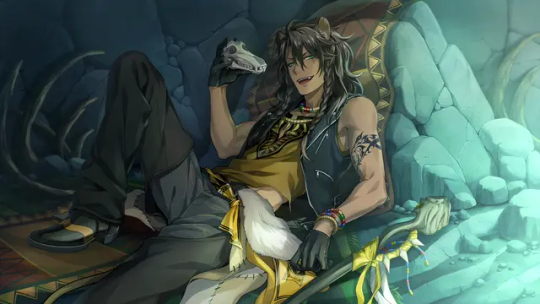
Aslan is a race in Arknights which is based on lions, they're somewhat a sub-race of the Felines which is based on cats and big cats. They originated from desert area of a country called Sargon, though many of them migrated to a country called Victoria, the Arknights equivalent of the United Kingdom. This race is known to bring the blood of royalty and prominent figures in politics.
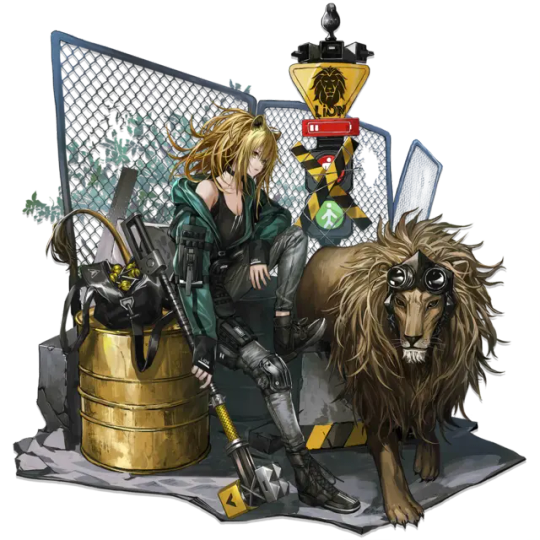
The only aslan character in-game so far is Siege, the leader of a street gang called the Glasgow Gang and the last heir of Victorian royalty. Personally I like how Siege's rough vibe as a gang leader as well as her royalty background kinda matches well with Leona. Even I've seen some fan-artists draw crossover fanarts of them and boy do I need more of them.

Since Leona was twisted from the Lion King, I believe that his referenced species is Panthera leo melanochaita, a sub-species of African lion mainly inhabiting Southern and Eastern Africa where many assumed was the setting where the Lion King take place.
Ruggie Bucchi | Race: Reproba/Rebbah
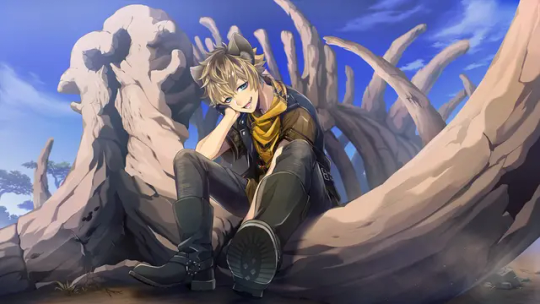
Reprobas in Arknights are based on hyenas and the can be recognized through traits such as pricked ears and tails with tufts of hair, spots, or stripes. Just like the aslans, they originated from desert area of Sargon as well though many of them ended up spreading everywhere across Terra. They're known to possess knowledge in wilderness survival which is also why many of them are working as mercenaries, biologist, geology researchers, and such.
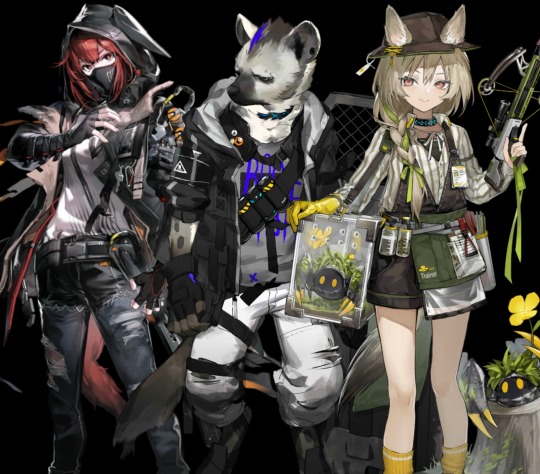
Since he's twisted from the hyenas of the Lion King, undoubtedly his referenced species would be the spotted hyena (Crocuta crocuta).

Jack Howl | Race: Lupo
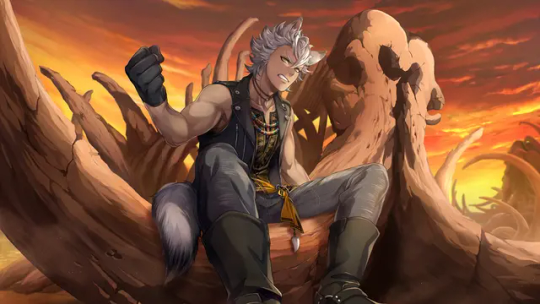
Lupo is a race based on wolves. Their traits can be noticed by their pricked ears and bushy tails. They originated and mostly found in a country called Siracusa which is Arknights' equivalent of Italy. Siracusan lupos are often associated with mafia-like community, though many of them are also working in other fields.

Now, there are no wolf character in the Lion King and from Jack's unique magic we can see that his wolf form definitely doesn't seem like any African wolves (not to mention that unlike Ruggie and Leona who came from Sunset Savannah, Jack came from Shaftsland). His fur is white and seems thick, indicating that he's most likely a part of wolf species that lives in colder climate. With that in mind, I think the best referenced species for Jack is the Eurasian wolf or common wolf (Canis lupus lupus).

· ✦ ·* . • · •. ✶˚ . ·✧ ˚ · . ·* . ✵. ✵ .· ✵ ✫˚ · · . ·✦ ˚ · . ⊹ · . * .. . °
And that's all for Savanaclaw. I made this as a stress-reliever but if there are anybody who read this post I really appreciate you for your time and I hope this could entertain you🥰 .
Nobody's asking but, yes, I'm gonna continue making the 2nd part of this. Hint:

Images & information sources:
https://arknights.fandom.com
https://arknights.wiki.gg/
https://twisted-wonderland.fandom.com/
https://www.wikipedia.org/
#twisted wonderland#twst#twst au#arknights#savanaclaw#jack howl#ruggie bucchi#leona kingscholar#twst headcanons#idk why I put so much on researching for this more than I did with my undergrad thesis
12 notes
·
View notes
Note
Besides the monkeys in JTTW, and the monkey mentioned in Investiture of the gods, or SWK's kids in Journey to the south, are there other monkeys?
In general? Billions probably.
In mythology? Thousands.
In Chinese mythology? Maybe a good dozen or so.
We got Wuzhiqi who is kinda an early inspiration for Wukong being the monkey demon that was trapped under the mountain. There are Guoran which is more mentioned in like poetry. The Zodiac Monkey which isn't really a character but still a thing. Juefu are morso just like early versions of monkey demons that raped men/women depending.
I can't say the rest are really "characters" but moreso just neat monkey facts in Chinese mythos. Like Gibbons being considered very cultivated because of their howling or 'singing.' I really think with the introduction of other mythos like Hanuman and the 'Mind Monkey' from Buddism that Sun Wukong was able to grow from his early perverted nature like in the Zaju play to the clever and loyal pilgrim in the Wu Cheng'en version.
22 notes
·
View notes